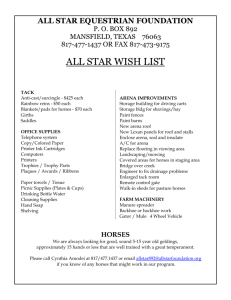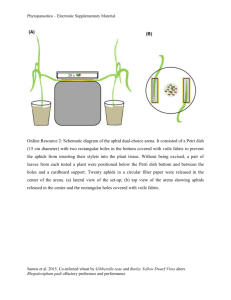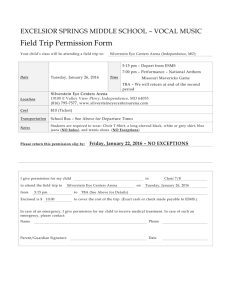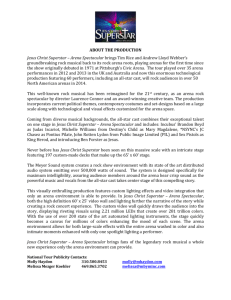ARENA - Coman
advertisement
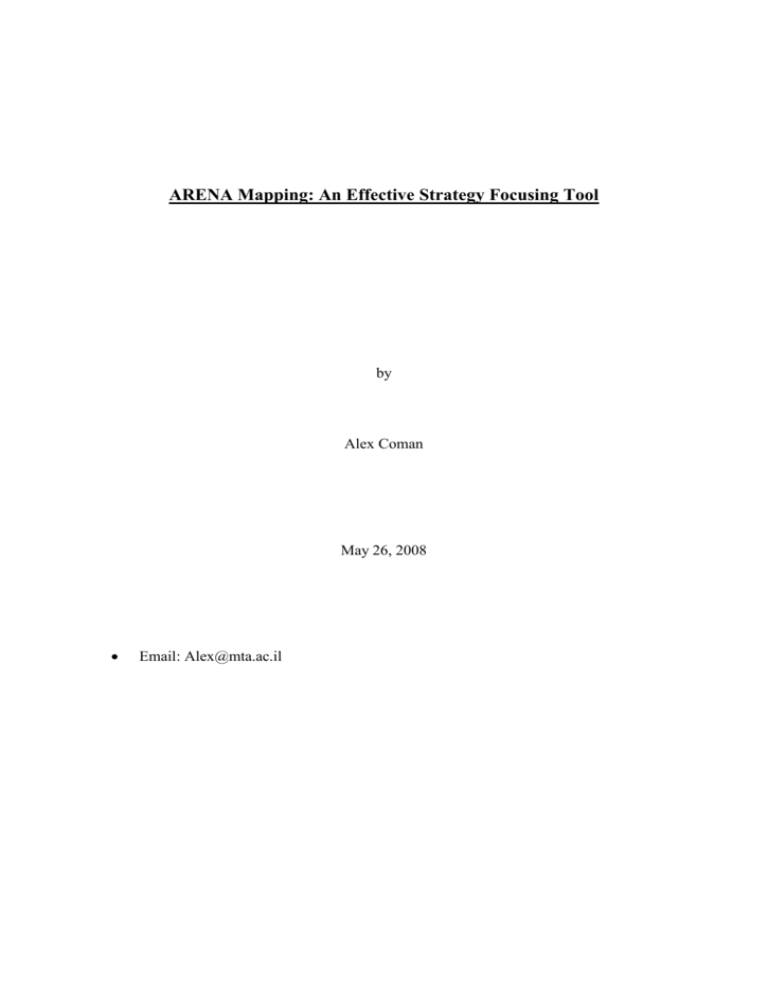
ARENA Mapping: An Effective Strategy Focusing Tool by Alex Coman May 26, 2008 Email: Alex@mta.ac.il Abstract ARENA is a graphical tool designed to map the business environment. Like other managerial tools such as the Gant chart and the Pareto diagram, the ARENA provides a concise single picture of the external actors influencing the organization’s value that can be used for decision making. The paper presents the ARENA model and demonstrates its applications. Cases are described and the ARENA is compared to existing models. Key words: Corporate Strategy, Focusing, Scenario Analysis, Theory of Constraints, ARENA 1 Introduction This paper presents the ARENA model, a graphical depiction of the firm’s business environment designed to assist managers in their strategic and tactical decision making, with the objective of improving the firm’s value. The tool addresses several needs of senior managers in the organization: 1. The global view: Some of the graphical focusing tools that are applied in the operational area can help executives gain the global view that they need to function effectively and make better use of their limited time and resources: Pareto analysis has established the rule that 20% of the variables account for 80% of the outcome, enabling people to focus in conditions of independent events. Pareto charts are common analytical tools (Ronen and Pass, 2007). The critical-path method (CPM) and the critical chain (CC) (Goldratt, 1997) enable managers to focus on a small number of elements. The CPM and CC visual representations are very useful in providing a global view of the whole project. The current-reality tree techniques (Ronen and Pass, 2007) and root-cause analysis in particular enable managers to focus on fundamental problems. The graphical representation showing the organization’s problems on a single slide facilitates managerial decision making and delegation of authority. However, a shortage of comprehensive focusing tools at the strategic level is one of the reasons that the operational improvements provided by these tools are not translated into strategic advantage often enough. The BCG (Boston Consulting Group) provides a methodology for classifying strategy but no translation into action items. The same applies to the GE-McKinsey model. Porter’s (1985) models list potential threats and provide stakeholder analysis, Mintzberg (1988) discusses generic 2 strategies, while Hamel and Prahalad (1994) discuss modern strategic directions. In short, one can not see the strategic forest for the trees. While each of these approaches addresses one or another facet of the strategic whole, the ARENA model enables the creation of a simple and clear strategic picture that can be translated into tactical changes in the organization. 2. A common interdisciplinary language: There is a distinct need for a common interdisciplinary language to connect managerial disciplines. Operations should be linked to marketing and logistics, finance should connect to marketing, and strategy should consider all of the firm’s strengths and weaknesses. Each discipline has its own distinct language, which does not make for effective communication and means that local improvements do not always translate into a global contribution to the firm’s value. The ARENA model provides a common language and a way out of the Tower of Babel. 3. Knowledge management: Today’s managers have ample strategic and operational information, which they can manage for the firm’s benefit by focusing on the appropriate domains and avoiding the danger of drowning in the mass of available data. ARENA’s function is to link the various information sources into a collaboration that will improve the firm’s value. In sum, the ARENA solution generates a simple graphical representation providing: 1. a global view, 2. a common interdisciplinary language 3. a tool focusing on relevant knowledge for decision making. A particularly notable example of an industry where ARENA could be usefully applied is that of today’s flourishing venture companies, which examine 10 to 12 potential ventures for each investment made. How can a manager understand the value of a potential startup in less than an hour? ARENA enables a faster grasp of a venture’s real potential and problems, making it possible to evaluate additional ventures and select the better few. 3 Section 2 of this paper presents and demonstrates the ARENA model. Section 3 illustrates its use by Nokia in the cellular telephony ARENA. Section 4 demonstrates its application for decision making. Section 5 concludes the article. Section 2: The ARENA model We present the ARENA model in three stages: A. Vocabulary – defining the “words”: “nouns” and “verbs” of the ARENA notation; B. Syntax – rules for linking “words”; and C. Semantics – guidelines for the effective modeling of a given business problem into an ARENA. A. Vocabulary. The ARENA vocabulary consists of three entity types (nouns) and four relation types (verbs). The three ARENA entity types are: 1. Firms, represented by solid rectangles, each denoting the firm’s name, e.g., IBM . A firm is typically associated with its competitors, supply chain, leading customers, major suppliers, substitutes, complementors, business partners, merger-and-acquisition (M&A) targets, etc. 2. Businesses and Markets, represented by dotted rectangles denoting the area of activity, e.g., Personal computers . They describe the firm’s business, substitutes, market segments, technologies, geographical regions, etc. 3. Monopolies and Regulatory Agencies are represented by thick solid Microsoft rectangles denoting the name, e.g., . Monopolies are major players such as Microsoft (and may accord only loosely to the legal or economic definition). Regulatory agencies and standards institutions define standards (ASA, ISO, GMP), authorize the marketing of drugs (FDA), regulate financial markets (the Federal Reserve), manage telecommunications resources (FCC), etc. The four ARENA relation types are: 4 1. Business relations, represented by a solid arrow. The arrow points in the direction of the product or service flow – from the supplier to the customer. The product or service’s name is indicated on or near the arrow. When several products or services are provided they are indicated separately. The following example indicates that IBM sells both computers and consulting services to its customers: IBM Hardware Consulting Customers . 2. Information flow relations, represented by a dotted arrow. The arrow points in the direction of the information flow – from the source to its destination. The medium used to communicate and the message transmitted are indicated on or near the arrow. Information flows relate in particular to marketing, advertising, promotion, etc. The following example indicates that IBM advertises itself via commercials on television as well as through internet sites: IBM Television: Internet: Image Technical Data Customers 3. Control, represented by a thick arrow. The arrow points from the entity that controls to the entity that is controlled. The controlled domain is indicated on or near the arrow. Control emanates typically from regulatory agencies, experts and consultants involved in decision making. Examples include physicians prescribing medication to patients, consultants selecting options: FCC Transmission Frequencies IBM 5 4. Integration, represented by an arrowless line. Horizontal integration or diversification is indicated by a horizontal line like the one linking Disney film studios with Disney’s amusement park businesses. Disney Disney Warner Amusement Parks Studios Films ABC CBS Networks . Vertical integration is indicated by a vertical line like the one linking Disney’s film studio businesses with ABC – a Disney-owned network. When integration is partial as a result of M&As, takeovers, spin-offs or joint ventures, ownership percentages are indicated near the owned entity: Microsoft NBC 50% 50% MSNBC . B. Syntax. ARENA’s syntax defines rules for the linkage of pertinent entities. The syntax consists of the following three elements. 1. Hierarchy. ARENA uses a Venn diagrammatic syntax, specializing Harel’s (1988) notation to hierarchically map business domains, segments within these domains and salient firms within these segments. The hierarchical notation conveys commonalities between technologies, businesses and markets, and provides the reader with a selective view. Citibank Commercial Merrill Lynch Charles Schwab Investment Banks AIG Visa Insurance Companies Credit/debit Cards Financial Services In the above example, the Financial Services industry is broken down for demonstration purposes into three businesses: banking, insurance and 6 credit/debit cards. The banking business is further broken down into commercial and investment banks. Citibank is an instance of a commercial bank; Merrill Lynch and Charles Schwab are instances of investment banks; AIG is an insurance company and Visa is in the credit card business. 2. Parsimony. Concise mapping of the business ARENA is recommended as it facilitates analysis and communication of ideas. Parsimony is achieved by linking, wherever possible, the highest levels of abstraction. In the following example, linking individual firms involves a “spaghetti” of nine arrows, which requires significant cognitive effort to decipher. Nestlé Tropicana Vons’ Sloan’s Hershey’s Zabar’s The same information can be communicated by a single arrow by aggregating Nestlé, Tropicana and Hershey’s into the “Suppliers” business class and Vons, Sloan’s and Zabar’s into the “Retailers” business class. Nestlé Vons’ Tropicana Hershey’s Suppliers Sloan’s Zabar’s Retailers Exclusive relationships between firms are still depicted, highlighting the exceptions to the rule. Another means of achieving representational economy is to ignore information flows when they are an integral part of the business relationship. In the above example, the addition of information flows of suppliers promoting new products and deals and retailers entering orders or providing feedback is implied by the business relationship and is therefore superfluous. Only nonredundant information flows should be included such as advertising, web sites, product specialists, etc. 7 3. Value System. A major goal of the ARENA is to provide a multidisciplinary platform for discussion and analysis. By positioning businesses along the value system, we achieve cognitive anchoring enabling professional experts to focus on their respective areas of competence. Businesses and markets are positioned so that suppliers are at the top of the ARENA; manufacturers are positioned below, followed by distributors and retailers. Final users are positioned at the bottom of the ARENA. Regulatory agencies and standards institutions are positioned above the markets they control. Ministry of Agriculture ` Hygiene Regulation Farmers Milk Dairies Cheese Restaurants Service 4. Consumers Cheese Retailers Products Consumers Thus, by scanning the ARENA from top (raw materials) to bottom (final users) one learns how value is added when products and services are refined in their flow down the value system. The value system syntax enables marketing and sales experts to focus on their areas of expertise, which are depicted in the ARENA from the firm down and relate to competitors, distribution systems, customer segmentation, advertising, business intelligence, etc. This so-called “downstream” region is consistently located in the lower part of the ARENA. Logistics and procurement experts focus on supply-chain management (SCM), which is located “upstream” in the upper part of the ARENA. R&D experts typically focus on technology suppliers and on emerging substitutes that are positioned near and above the firm. 8 Finally, a major goal of the ARENA is to bridge disciplinary chasms. By arranging the value system from top to bottom we assure that vertical integration will be depicted vertically, and horizontal integration – horizontally, which is not the case with many current models. C. Semantics: ARENA’s semantics provide guidelines for the effective modeling of a given business problem into a single picture. The process should start with a well-defined decision problem such as the selection of manufacturing partners, distribution channels, new technologies, potential buyers for the firm, etc. Next, we draw the firm, its major competitors, substitutes and complementors, and develop the ARENA in the desired direction by adding key suppliers, distribution channels, potential coalitions, regulators, standards institutions, market segments, advertising channels, key decision makers, etc. The ARENA’s decision-making process is further developed in the following section. Section 3: Nokia’s ARENA analysis The following discussion of Nokia’s business strategy derives from its investor relations presentations, according to which its current ARENA recognizes two customer segments: individuals and enterprises. Nokia’s analysis of its gross margins reveals that while those from plain mobile phones reach around 35%, those from multimedia average 40% and those from enterprise solutions exceed 45%. Presently, it reaches its end users through two channel types: (1) mobile operators – or Businessto-Business, and (2) distributors, value-added-resellers, and system integrators. Nokia is unhappy with this situation. It considers its reach today to be “niche market” and wants to upgrade to “mass market”. Nokia starts by drawing its ARENA, which it perceives to include the following: 1. Networking providers such as Cisco 2. Voice applications from companies such as Nortel 3. Data applications from companies such as SAP 4. Security application providers such as CheckPoint 5. Mobileware manufacturers such as RIM 6. Data devices – PCs and personal-data-assistants (PDAs) 9 7. Desk phones 8. Mobile operators such as Vodafone 9. Distributors, value-added-resellers, and system integrators 10. End users: individuals and enterprises. Next, Nokia focuses on areas of the ARENA in which it does not aim to do business. It starts by eliminating competition in networking, voice applications, data applications, mobile operators, data devices and desk phones. It then determines to create an “independent software revenue stream” out of its currently insignificant one. Its initiative to create “Nokia services” starts by offering security services, and then analyzing the use of “internet services on Nokia devices”. It starts by focusing on maps, identifying six distinct applications for them: in car navigation, routing, pedestrian guidance, searching maps for content, user generated content collection and management, sharing and publishing of map content and gathering – getting together. Deploying each of these strategic decisions into action requires Nokia to individually develop the relevant capabilities, or to acquire or partner with players in the ARENA. Map management for example could be achieved by partnering with current players in the ARENA, namely Google-Maps or Microsoft-Virtual-Earth. An alternative 10 scenario would consist of acquiring players in the ARENA and developing a new core competence for Nokia. The number of make, partner or buy scenarios is huge and is resolved by mapping attractive players in the ARENA. It should be noted that while Nokia explicitly decided not to compete with the mobile operators, its service offerings compete with some of those currently offered by mobile operators and could therefore result in channel conflicts. Section 4: Decision making and the ARENA model A three-stage methodology was developed for decision making: 1. Define the business ARENA 2. Focus on key areas within the ARENA 3. Action – act to improve your ARENA position. We illustrate the process by considering Vocaltec, a pioneer in the Voice-over-IP ARENA. Vocaltec’s strategy, which focused on providing end users with software to help them bypass their telephone service providers, was to enable customers to dial a local number to their internet service providers (ISPs) and use this connection for long-distance telephone calls. This strategy, which called for the development of an end-user solution to be mass marketed in the consumer market, proved ineffective. The company suffered losses and two years later turned to providing Voice-over-IP solutions for PTTs, incumbent local exchange companies (ILECs) and competitive local exchange companies (CLECs). The new strategy enabled Vocaltec to reduce its costs, improve the utilization of its infrastructure investments and deploy advanced services over existing wires. This strategic shift required fundamental changes in Vocaltec’s products, R&D, marketing and service operations. While successful, it was two years before the strategic change occurred, by which time bigger and stronger competitors were sharing Vocaltec’s technology. Using the ARENA methodology Vocaltec could have reached its decision at an earlier stage, by the following scenario: 11 1. ARENA: Vocaltec first builds its ARENA by charting the telecommunications market. At the top it maps equipment manufacturers. These are broken down into telephony switching equipment, data switching equipment, modems and other telephony equipment for end users. Underneath it develops the value system by introducing pertinent communications service providers: PTTs, ILECs, ISPs, cable, cellular, etc. These are linked to their target markets: business and residential. Nortel Cisco Siemens Equipment and Technology Vocaltec Distributors British Telecom NT T PTTs Deutche Telecom Business ISPs Dealers Analogue VoIP Residential Vocaltec is depicted as a de-facto monopoly in the VoIP market since it had Users about 80% of the emerging market in that area in 1995. In order to achieve its goal Vocaltec has to develop a network of distributors and dealers to support its products. 2. : Focus: An analysis shows that as a small startup Vocaltec does not have the resources required to reach a mass market of end users, providing the software free of charge. The solution can only be marketed to technologically savvy internet users who know how to install the product. Of this limited population only those willing to significantly sacrifice quality of service in return for bypassing the PTT’s tolls are potential customers. Financially, the company lacks the capital required to establish international distribution channels, advertising and service. On the other hand the service provider market is characterized by significantly larger deals, requiring fewer marketing resources. However, it requires higher quality standards. Hence, the operational implications. 12 3. Action: Once the strategic goal has been redefined as providing VoIP solutions to PTTs, the ARENA is redrawn: Nortel Cisco Siemens Equipment and Technology British Telecom Business NT T PTTs Vocaltec Deutche Telecom Analogue VoIP Residential Vocaltec now charts a list of action items: Users Size: supplying large PTTs implies that Vocaltec can remain a small hightech company providing cutting edge technologies to old-economy customers. Quality: Carrier grade quality levels require products with no single point of failure. This is a hurdle to be tackled. Product: the product has to be redefined and its characteristics changed. While a consumer product must be foolproof and extremely friendly, the new product definition means that it is operated by professional PTT staff. Friendliness loses importance, while configurability and manageability gain importance. Research and Development: While the previous solution handled relatively small amounts of traffic, the new strategy calls for handling major bandwidths. This calls for new competencies to handle the new bottlenecks. Production: The old strategy called for an ultimate volume of thousands of shipments per week. The new strategy implies a small number of sophisticated software and hardware solutions to be produced. 13 Support: The old strategy called for a multilingual support center capable of handling thousands of naïve questions. The new strategy caters to a smaller volume, English-speaking professional audience. Marketing and sales were the constraint of the old strategy. The focus was on the development of distribution networks. The new strategy calls for massive presence at professional shows where a couple of large deals per year supply major growth. The human resources profile of the company changes: fewer employees, more technology professionals, less marketing. More business development is aimed at identifying potential corporate buyers (Deutche Telecom ultimately bought a stake in Vocaltec) and there is less support. Vocaltec focuses on the recruitment of professionals with a strong carrier grade background (with PTT and telecom equipment manufacturers) to complement its computer strength with telephony know-how. The financing burden is eliminated. The original strategy called for vast investments in the creation of distribution networks, the mass production of product packages and the feeding of these products into the distribution network. The new strategy with equipment manufacturers and PTTs as the main market places a significantly lower burden on finances. There is no need for deep pockets to establish an international presence. Section 5: Conclusion The ARENA model provides a visual notation for strategic analysis. Its methodology calls for the creation of a picture of the major pertinent players, focusing on key businesses and market segments, and translating the strategy into a set of action items. By updating the ARENA periodically or whenever major changes occur, we obtain a closed-loop instrument with a built-in feedback mechanism. 14 References Goldratt, E.M. (1997), Critical Chain (Croton on Hudson, NY: North River Press). Hamel, G. and C.K. Prahalad (1994), Competing for the Future (Harvard Business School Press). Harel, D. (1988), On Visual Formalisms, Communications of the ACM 31(5), May, 514-530. Mintzberg, H. (1988), Generic Strategies, Advances in Strategic Management 5, 1-67. Porter, M.E. (1985), Competitive Advantage (New York: The Free Press). Ronen, B. and S. Pass (2007), Focused Operations Management: Achieving More with Existing Resources (Hoboken, NJ: John Wiley and Sons). 15
